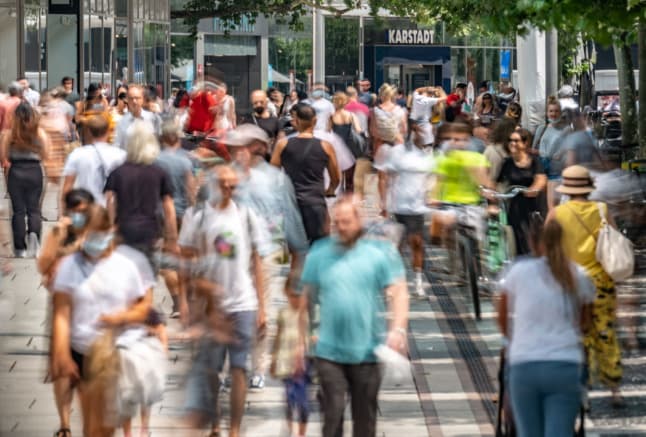Fact check: Will Germany's Covid incidence really reach 800 by October?

Health Minister Jens Spahn said this week that if the current trend continues, Germany could see its 7-day Covid incidence rise to 800 infections per 100,000 people by October. Might this happen? Here's what a data expert had to say.
Spahn's frightening prognosis was made on the basis of the current upward swing in infections. Having dipped all the way down to 4.9 Covid cases per 100,000 people within seven days on July 6th, the 7-day incidence of infections broke into double digits this week, and currently stands at 13.2.
READ ALSO: IN NUMBERS: Where are Covid cases rising in Germany – and what does it mean?
"If the incidence continues to double like this, every 12 days, then we will exceed 400 in September, 800 in October," he told reporters on Wednesday during a press conference. "Do we want to let this happen?"
That's Spahn's view - but what do the data experts say?
Statistician Katharina Schüller, who sits on the board of the German Statistical Society, told Germany's Focus Online that the forecast could "theoretically" be correct.
However, in her view, one essential factor is missing from Spahn's prognosis: the fact that the number of vaccinated adults in Germany is rising on a daily basis.
That means that two potential scenarios have to be considered based on the current trends, added Schüller.
The first doesn't take into account the climbing vaccination rates and assumes that the current 'R' rate - the number of people infected by one person with Covid-19 - remains the same as it is currently.
READ ALSO:
- What’s behind Germany’s rising Covid infection rates?
- Merkel urges Germans to get vaccinated amid ‘exponential growth’ of Covid infections
The second, more likely scenario, is that the number of people vaccinated continues to rise steadily, bringing with it a reduction in the 'R' rate. "If the immunisation is taken into account, the reproductive rate [of Covid] decreases somewhat," explains Schüller.
What infection rates would we see in each scenario?
In the first scenario, where vaccinations aren't considered, we could experience incidences of 50 Covid cases per 100,000 residents by the start of August, 100 by the middle of August, and 200 by the middle of September.
"According to these calculations, Spahn's prediction would come true," explained Schüller. The incidence would then be at least 800 in October, and possibly 951 on October 6th.
„Wir entscheiden jetzt, jetzt in diesen Tagen des Julis darüber, wie September, Oktober, November werden“ — in Bezug auf die Inzidenzzahlen und die Ausbreitung der #Corona Pandemie. Das ist eine wichtige Warnung von Gesundheitsminister @jensspahn.https://t.co/4FtRSwn3ew
— Marcel Fratzscher (@MFratzscher) July 21, 2021
Marcel Fratzcher, Professor for Macroeconomics at Humboldt University, describes Spahn's comments as "an important warning".
In a second scenario, however, where vaccinations are talken into account, we could experience incidences of 50 Covid infections per 100,000 people by the middle of of August, 100 by the end of August, and 200 by the middle of September.
Could we still see an incidence of 800 - despite vaccinations?
According to the statistics expert, it's very unlikely - because a number of factors, from human intervention to weather events, could have an impact on the figures in a way that is hard to predict.
If Germany looks as if it is on a path towards super-high incidences in the triple-digits, will politicians and health experts risk reaching that point, along with the associated hospitalisations and loss of life?
"The previous line has always been: no, we don't want to," Schüller told Focus Online. "But that is a political decision and not one that can be 'calculated'. That's why we will probably never reach the incidence of 800, because politics will very likely act beforehand."
Though the current incidence is barely over 10, politicians such as Spahn are already urging caution among the population.
READ ALSO: ‘Prepare for autumn and winter’: Germany’s RKI warns of Covid spike
"It's about wearing a mask indoors. Getting tested regularly. If you haven't been vaccinated yet, get vaccinated," said Spahn. "Now, in these days of July, we're already deciding how September, October and November will be."

Health Minister Jens Spahn (left) has warned that people's actions in July will affect the infection rates we see in August. Photo: picture alliance/dpa/Reuters/Pool | Annegret Hilse
Could we see another lockdown situation?
That's hard to say at the moment - but the signals from politicians suggests that public life could remain open a lot longer than it has previously.
In previous months, the German government has seen a 7-day incidence of 50 Covid cases per 100,000 people or more as a critical threshold for introducing new measures and partial lockdowns.
However, if a large proportion of people are vaccinated and protected against severe courses of the virus and hospitalisations, the country can probably deal with much higher rates of infection before new restrictions are required.
If 75 percent of people get inoculated, a threshold of 200 Covid cases per 100,000 people in seven days would be more appropriate, since three quarters of people would theoretically be protected.
As Spahn summarised at the press conference: "200 is the new 50."
Comments (2)
See Also
Spahn's frightening prognosis was made on the basis of the current upward swing in infections. Having dipped all the way down to 4.9 Covid cases per 100,000 people within seven days on July 6th, the 7-day incidence of infections broke into double digits this week, and currently stands at 13.2.
READ ALSO: IN NUMBERS: Where are Covid cases rising in Germany – and what does it mean?
"If the incidence continues to double like this, every 12 days, then we will exceed 400 in September, 800 in October," he told reporters on Wednesday during a press conference. "Do we want to let this happen?"
That's Spahn's view - but what do the data experts say?
Statistician Katharina Schüller, who sits on the board of the German Statistical Society, told Germany's Focus Online that the forecast could "theoretically" be correct.
However, in her view, one essential factor is missing from Spahn's prognosis: the fact that the number of vaccinated adults in Germany is rising on a daily basis.
That means that two potential scenarios have to be considered based on the current trends, added Schüller.
The first doesn't take into account the climbing vaccination rates and assumes that the current 'R' rate - the number of people infected by one person with Covid-19 - remains the same as it is currently.
READ ALSO:
- What’s behind Germany’s rising Covid infection rates?
- Merkel urges Germans to get vaccinated amid ‘exponential growth’ of Covid infections
The second, more likely scenario, is that the number of people vaccinated continues to rise steadily, bringing with it a reduction in the 'R' rate. "If the immunisation is taken into account, the reproductive rate [of Covid] decreases somewhat," explains Schüller.
What infection rates would we see in each scenario?
In the first scenario, where vaccinations aren't considered, we could experience incidences of 50 Covid cases per 100,000 residents by the start of August, 100 by the middle of August, and 200 by the middle of September.
"According to these calculations, Spahn's prediction would come true," explained Schüller. The incidence would then be at least 800 in October, and possibly 951 on October 6th.
„Wir entscheiden jetzt, jetzt in diesen Tagen des Julis darüber, wie September, Oktober, November werden“ — in Bezug auf die Inzidenzzahlen und die Ausbreitung der #Corona Pandemie. Das ist eine wichtige Warnung von Gesundheitsminister @jensspahn.https://t.co/4FtRSwn3ew
— Marcel Fratzscher (@MFratzscher) July 21, 2021
Marcel Fratzcher, Professor for Macroeconomics at Humboldt University, describes Spahn's comments as "an important warning".
In a second scenario, however, where vaccinations are talken into account, we could experience incidences of 50 Covid infections per 100,000 people by the middle of of August, 100 by the end of August, and 200 by the middle of September.
Could we still see an incidence of 800 - despite vaccinations?
According to the statistics expert, it's very unlikely - because a number of factors, from human intervention to weather events, could have an impact on the figures in a way that is hard to predict.
If Germany looks as if it is on a path towards super-high incidences in the triple-digits, will politicians and health experts risk reaching that point, along with the associated hospitalisations and loss of life?
"The previous line has always been: no, we don't want to," Schüller told Focus Online. "But that is a political decision and not one that can be 'calculated'. That's why we will probably never reach the incidence of 800, because politics will very likely act beforehand."
Though the current incidence is barely over 10, politicians such as Spahn are already urging caution among the population.
READ ALSO: ‘Prepare for autumn and winter’: Germany’s RKI warns of Covid spike
"It's about wearing a mask indoors. Getting tested regularly. If you haven't been vaccinated yet, get vaccinated," said Spahn. "Now, in these days of July, we're already deciding how September, October and November will be."

Health Minister Jens Spahn (left) has warned that people's actions in July will affect the infection rates we see in August. Photo: picture alliance/dpa/Reuters/Pool | Annegret Hilse
Could we see another lockdown situation?
That's hard to say at the moment - but the signals from politicians suggests that public life could remain open a lot longer than it has previously.
In previous months, the German government has seen a 7-day incidence of 50 Covid cases per 100,000 people or more as a critical threshold for introducing new measures and partial lockdowns.
However, if a large proportion of people are vaccinated and protected against severe courses of the virus and hospitalisations, the country can probably deal with much higher rates of infection before new restrictions are required.
If 75 percent of people get inoculated, a threshold of 200 Covid cases per 100,000 people in seven days would be more appropriate, since three quarters of people would theoretically be protected.
As Spahn summarised at the press conference: "200 is the new 50."
Join the conversation in our comments section below. Share your own views and experience and if you have a question or suggestion for our journalists then email us at [email protected].
Please keep comments civil, constructive and on topic – and make sure to read our terms of use before getting involved.
Please log in here to leave a comment.